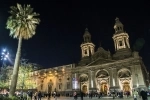Cathedral of Santiago. Santiago - CHILE
Direccion:
Plaza de Armas, Santiago Phone: + 56 22787 5600
The Cathedral is located on a site limited by street banner, and the Cathedral Main Square entrance is on the latter. The present building dates back to 1748, however, before he built another, almost on the same site, which by earthquakes or fire, were destroyed. The Cathedral of Santiago started in the year 1566 and was completed around 1600. Its dimensions were smaller than the present, but with careful jewelry. Its main entrance was by the current Cathedral Street, a feature that remained until the eighteenth century. In 1648 an earthquake severely affected the construction which was quickly touched by the initiative of Brother Gaspar de Villarroel. However, apparently this book was not very strong, because in 1657 an earthquake almost completely ruined its structure, making its second restoration took place between 1662 and 1687, when it was consecrated. Because of the earthquake of 1730, it was determined that the arrangements made forty years ago, had not been a good solution, therefore we had to build way back in 1748 agreed to build a new cathedral, which should be larger and more oriented square. To change the main entrance to the temple, it was necessary to buy land from the corner formed by the current flag and Cathedral streets, because no one wanted to leave the faithful without prayer duration of the construction.
The new temple was entrusted to the steward Mat?as Acu?a V?squez, who had to achieve a larger church, and also, resistant to future earthquakes. The bishop of Santiago, Juan Gonz?lez Melgarejo, was completely committed to this work and gave the necessary impetus for its construction. In 1768, twenty years after the start of the work was completed two thirds of the church. A year later, a fire destroyed the old building and most of the works of art that were preserved from the seventeenth century, which gave further impetus to the work. In 1775 opened the back and the new church was handed over to the cult.
However missing for the Cathedral of Santiago was listed, because in 1780 he was appointed the Italian architect Joaquin Toesca temple to complete the task he had undertaken Toesca was not simple, was the final project involving the frontispiece, respecting plant defined in advance and made by foundations. The solution proposed for the main facade was neoclassical, preferably Tuscan. Thus the architect completed the work, which resulted in an elegant facade, however, it did not conform to the inhabitants of Santiago.
By 1830 the building was almost completed, and in 1840 Pope Gregory XVI makes this cathedral, this car was lost erection by Pope Pius IX that allows a new, leaving as the final date of September 29, 1873. In 1846 began the construction of the Capilla del Sagrario, which was finished by Eusebius Chelli. In the late nineteenth century, Archbishop Mariano Casanova ordered a series of changes that transformed the Cathedral in the building we see today. The new Archbishop had decided to finish the cathedral, which has hired Ignacio Cremonesi and began work in 1898. In 1906, Casanova was able to consecrate the temple changed. Cremonesi is design is inspired by a Roman or Tuscan style, the changes in the stone was covered in stucco and wood paneling was replaced by a painted sky scene in boxes. Inside the church was made up of three ships: one central and two lateral heights. The roof is formed by a barrel vault that rests on pillars run. Basically, on the altar, the dome in a dome topped with a circular drum. In front of the altar is the choir and later the space for the faithful. The decor is rich in paintings and gilded. The sky of the aisles is composed of small domes, one in each leg, which are separated by semicircular arches. The ships are communicated between them behind the altar, which lacks apse. The existing tower was replaced by two new towers that share the upper facade, on which the images were installed in St. James, Assumption of the Virgin and Santa Rosa.
It highlights the high altar, built in Munich in 1912 with white marble and bronze applications lapizl?zuli; the chapel for the Blessed Sacrament, a copy of the San Juan and San Pablo Martyrs in Rome, the body, and the two pulpits seat of the altar, made of mahogany by Bavarian Jesuits, during the eighteenth century.

